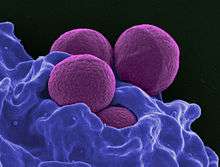Broad-spectrum antibiotic
A broad-spectrum antibiotic is an antibiotic that acts on the two major bacterial groups, gram-positive and gram-negative,[1] or any antibiotic that acts against a wide range of disease-causing bacteria.[2] These medications are used when a bacterial infection is suspected but the group of bacteria is unknown (also called empiric therapy) or when infection with multiple groups of bacteria is suspected. This is in contrast to a narrow-spectrum antibiotic, which is effective against only a specific group of bacteria.[3] Although powerful, broad-spectrum antibiotics pose specific risks, particularly the disruption of native, normal bacteria and the development of antimicrobial resistance. An example of a commonly used broad-spectrum antibiotic is ampicillin.[3]

Bacterial targets
Antibiotics are often grouped by their ability to act on different bacterial groups. Although bacteria are biologically classified using taxonomy, disease-causing bacteria have historically been classified by their microscopic appearance and chemical function. The morphology of the organism may be classified as cocci, diplococci, bacilli (also known as "rods"), spiral-shaped or pleomorphic. Additional classification occurs through the organism's ability to take up the Gram stain and counter-stain; bacteria that take up the crystal violet dye stain are referred to as "gram-positive," those that take up the counterstain only are "gram-negative," and those that remain unstained are referred to as "atypical." Further classification includes their requirement for oxygen (ie, aerobic or anaerobic), patterns of hemolysis, or other chemical properties. The most commonly encountered groupings of bacteria include gram-positive cocci, gram-negative bacilli, atypical bacteria, and anaerobic bacteria.[4] Antibiotics are often grouped by their ability to act on different bacterial groups. For example, 1st-generation cephalosporins are primarily effective against gram-positive bacteria, while 4th-generation cephalosporins are generally effective against gram-negative bacteria.
Empiric antibiotic therapy

Empiric antibiotic therapy refers to the use of antibiotics to treat a suspected bacterial infection despite lack of a specific bacterial diagnosis. Definitive diagnosis of the species of bacteria often occurs through culture of blood, sputum, or urine, and can be delayed by 24 to 72 hours.[5] Antibiotics are generally given after the culture specimen has been taken from the patient in order to preserve the bacteria in the specimen and ensure accurate diagnosis.[4] Alternatively, some species may be identified through a urine or stool test.[4]
Risks
Disruption of normal microbiome
There are an estimated 10–100 trillion multiple organisms that colonize the human body.[6] As a side-effect of therapy, antibiotics can change the body's normal microbial content by attacking indiscriminately both the pathological and naturally occurring, beneficial or harmless bacteria found in the intestines, lungs and bladder.[7] The destruction of the body's normal bacterial flora is thought to disrupt immunity, nutrition, and lead to a relative overgrowth in some bacteria or fungi.[8] An overgrowth of drug-resistant microorganisms can lead to a secondary infection such as Clostridium difficile ("C. diff") or candidiasis ("thrush").[3] This side-effect is more likely with the use of broad-spectrum antibiotics, given their greater potential to disrupt a larger variety of normal human flora.[7]
Examples of broad-spectrum antibiotics
In humans:
- Aminoglycosides (except for streptomycin)
- Ampicillin
- Amoxicillin/clavulanic acid (Augmentin)[9]
- Carbapenems (e.g. imipenem)
- Piperacillin/tazobactam
- Quinolones (e.g. ciprofloxacin)
- Tetracyclines
- Chloramphenicol
- Ticarcillin
- Trimethoprim/sulfamethoxazole (Bactrim)
In veterinary medicine, co-amoxiclav, (in small animals); penicillin & streptomycin and oxytetracycline (in farm animals); penicillin and potentiated sulfonamides (in horses).
References
- Ory, Edwin M. (1963-07-27). "The Use and Abuse of the Broad Spectrum Antibiotics". JAMA: The Journal of the American Medical Association. 185 (4): 273. doi:10.1001/jama.1963.03060040057022. ISSN 0098-7484.
- Clayton L. Thomas, ed. (1993). Taber's Cyclopedic Medical Dictionary (17th ed.). F. A. Davis Co. ISBN 978-0-8036-8313-6.
- S. J. Hopkins (1997). Drugs and Pharmacology for Nurses (12th ed.). Churchill Livingstone. ISBN 978-0-443-05249-1.
- Kasper, Dennis L.; Larry Jameson, J.; Hauser, Stephen L.; Loscalzo, Joseph; Fauci, Anthony S.; Longo, Dan L. (2015-04-08). Harrison's principles of internal medicine. Kasper, Dennis L.,, Fauci, Anthony S., 1940-, Hauser, Stephen L.,, Longo, Dan L. (Dan Louis), 1949-, Jameson, J. Larry,, Loscalzo, Joseph (19th ed.). New York. ISBN 9780071802154. OCLC 893557976.
- Leekha, Surbhi; Terrell, Christine L.; Edson, Randall S. (February 2011). "General Principles of Antimicrobial Therapy". Mayo Clinic Proceedings. 86 (2): 156–167. doi:10.4065/mcp.2010.0639. ISSN 0025-6196. PMC 3031442. PMID 21282489.
- Ursell, Luke K; Metcalf, Jessica L; Parfrey, Laura Wegener; Knight, Rob (August 2012). "Defining the Human Microbiome". Nutrition Reviews. 70 (Suppl 1): S38–S44. doi:10.1111/j.1753-4887.2012.00493.x. ISSN 0029-6643. PMC 3426293. PMID 22861806.
- E. A. Martin (2003). Oxford Concise Medical Dictionary (6th ed.). Oxford University Press. ISBN 978-0-19-860753-3.
- Rafii, Fatemeh; Sutherland, John B; Cerniglia, Carl E (December 2008). "Effects of treatment with antimicrobial agents on the human colonic microflora". Therapeutics and Clinical Risk Management. 4 (6): 1343–1358. doi:10.2147/tcrm.s4328. ISSN 1176-6336. PMC 2643114. PMID 19337440.
- Coon, Eric R.; Quinonez, Ricardo A.; Morgan, Daniel J.; Dhruva, Sanket S.; Ho, Timmy; Money, Nathan; Schroeder, Alan R. (2019-04-01). "2018 Update on Pediatric Medical Overuse: A Review". JAMA Pediatrics. 173 (4): 379. doi:10.1001/jamapediatrics.2018.5550. ISSN 2168-6203.